Every now and then, people argue whether “zones” in an MMO are a good or a bad thing. Just today, the discussion came up again in replies to a post by HarbingerZero. I first wanted to answer there, but then I ended up with a full post. So here you are!
First of all, I think we have to make sure that we don’t conflate two concepts into the word “zone”. When people think of zones, they can mean two different things:
- Self-contained pieces of terrain, which you can only leave for other zones through specific points and loading screens.
- Thematically grouped areas (the “snow zone” or the “lava zone”) which are connected to other zones without load screens.
I’ll call the first one “technical zones” and the second one “thematical zones”.
Technical zones
Everquest (both I and II) is probably the king here. Many original EQ zones were quite small, and to change from one to another required you staring at loading screens, sometimes for a long time. This was probably more a technical limitation that anything else: by keeping each zone small, the number of players that could interact with each other also was kept low. Keep in mind that, in an extreme case, each player’s actions need to be sent to every other player in a zone, so you end up with quadratic growth – which is never a good thing. Of course, things like “spheres of awareness” (I will only be informed by the game about things happening in my view range) help a lot. Still, you’re typically limited by your servers’ computing power, because it is much, much harder to have more than one server handle a zone, because you run into the classic parallelization problems and open yourself up to a lot more bugs (which are hard to debug, to boot). So, historically, small, self-contained zones made a lot of sense.
Small zones also make it easier to handle and redistribute the load. In EVE Online, each star system is a zone, though the loading screen in this case is the warp tunnel, so it’s hidden from plain view. Most star systems in EVE are almost completely empty almost all the time. Each server therefore handles a bunch of zones. However, if a system suddenly becomes very active (think of those several-thousand player battles), this architecture allows them to dynamically redistribute the load. The server sheds all its other systems off to other servers, and focuses on that one system only. (It’s still often not quite enough, so EVE uses a trick called “time dilation”, in which everybody in that system slows down by a certain percentage. Everything goes slower: flying, shooting, etc. That allows the server to keep up with the load.)
On the other hand, we see that these days, it’s not really necessary to have these “hard” zone lines. WoW created an almost zoneline-free world in 2004. LotRO did so, too, and even has “dynamic layers” in which copies of an area are created if too many players flock in one spot. (Though I’m not sure whether that’s for technical or game design reasons). I don’t remember enough of the even earlier games to speak about them, but didn’t UO have no loading screens, either?
So if it is technically possible to make a world without loading screens, is there any other reason to have them in your game? I can see an argument for them in a world that switches between multiple-instance zones (“instanced dungeons”) and single-instance zones (“open world”). In that case, the loading screen does not only mask the potential waiting time to process the additional load on the server (create a new copy of the zone, etc.), but it also functions as a visual cue to the player that they are transitioning from one presentation of the game world to another.

Perfectly rectangular EQ zone. Also note the curved or “Z”-style exits, designed so you will never have a view of the adjacent zone, which of course isn’t there at all.
Other than that, in my opinion, there is no compelling reason to have zone lines with loading screens in your game. They only detract from your experience. They chop the world into tiny blocks that are only roughly pieced together. When I go from home to work, I don’t have to stare at a loading screen when I pass a certain point. When I go on vacation, I don’t have to pass 15 checkpoints with loading screens, either. Loading screens have no equivalent in the real world, and they also don’t give us any benefit by being better than what we’re used to from the real world. Also keep in mind that the strict separation means that I can’t “peek over” into the other zone. Even if I’m standing right at the zone line, I can’t see what’s happening on the other side. That often leads to the infamous “rectangle with mountains around it” zone design, with zone exits with curved or bent tunnels that make sure I won’t catch a glimpse of the adjacent zone – which of course isn’t even there, because the zone is all there is, as far as the server is concerned.
My opinion: only chop up your world into zones if you have to for technical reasons. Otherwise don’t.
Thematical zones
Back in the day, before MMOs, before 3D graphics, before high-quality 2D graphics, there was a very technical reason for zone themes. Remember Super Mario Bros? Outside level, night level, castle level, and so on… The memory, computing and display power were so limited that it made sense to only have a small set of tiles available for each level. Palette shifting (recoloring existing visual assets) saved space, so you had levels that used the same assets in different colors. For the same technical reasons, every level was also separated from the others by a technical zone boundary.
MMOs have often not deviated much from this zone idea. Have a look at this (pre-cataclysm, but it didn’t change much afterwards) map of WoW’s Searing Gorge, a typical “lava zone” with lots of dark ash and open lava pools:

Circle are entry and exit points, arrows show the adjacent zones’ themes.
If you leave lava-land, you can either go to snow-land, or temperate-grasslands-land, or desert-land. That doesn’t really make much sense at all, geographically speaking. There is no savannah between the temperate grasslands and the desert. A lot of the other transitions aren’t impossible, (snow to grasslands, lava to the others), but the combination of all of them in so little space is quite implausible. In addition, even though there are no loading screens, the zone lines are very visible. Note that I chose searing Gorge also because there are three distinct entry and exit points. Other zones are more open, but you also get the same border-like feel when the scenery suddenly changes.
I collected some examples of what I mean. Click the images for larger sizes and captions with explanations! (Also, it’s the first time I used this gallery feature. If it doesn’t work as intended, please tell me.)
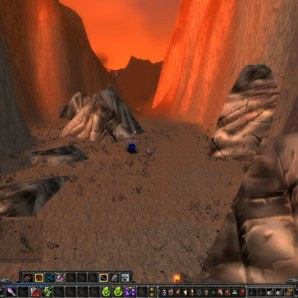
Looking from Searing Gorge into Badlands. Spot the zone line!
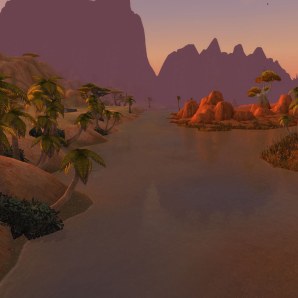
Standing on the bridge between Durotar and the Barrens. A bit more subtle, but still noticeable.
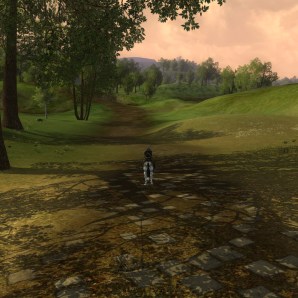
Border between Bree-land and the Lone-lands. Looking towards Bree-land: green grass, birch and linden trees…
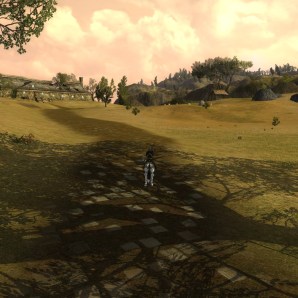
… turning around: suddenly a more mediterranean feel with stone pine-like trees.
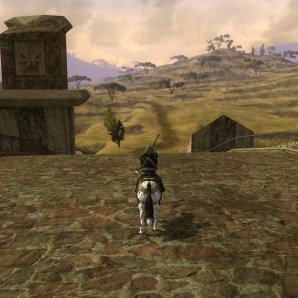
At the other end of the zones: Lone Lands still with a dry lands feel…
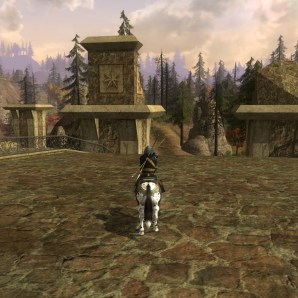
…but the Trollshaws suddenly feature reddish mountains and spruces?
This, perhaps more than all the other things people mean when they say “theme park”, reminds me of theme parks. Bored of Desert Land? Visit Lava Land! It’s just around the corner! I wonder where the preference for that sort of design comes from. Is it because each zone gets a few design sketches, and then a staff of people who populate it without much interaction with the designers of the adjacent zones? It doesn’t feel very world-like at all.
This behavior isn’t restricted to zone lines, though. Often, you end up with “sub-zones” that have a different feel. The evil camp in the forest, the fiery mountain in the plains. Palette shifts are very popular for these kinds of areas: Just change the “dominant” color, as if somebody put a color filter in front of your camera. You know what I mean: when you stand in green fields, then take a step forward, and suddenly the sky becomes purple and the grass you stood on turns gray, then you take the step back and everything is as it was before. It always felt silly to me. Why would the whole sky suddenly change color from one second to another? Why would the grass suddenly look dead and burned, and, even worse, look fine again if I take a step back? The colors support the theme of the zone, I get that, but the change is so sudden that it feels silly. I thought these days we wouldn’t have to resort to such drastic hacks any more. A more gradual change should be easy enough to implement, shouldn’t it?
I guess that’s what it comes down to, when I look at all those points: gradual change. A desert doesn’t suddenly become a forest within two steps, light doesn’t change that drastically either. A good world should have gradual changing scenery. Yes, that probably also makes it a lot larger, because you need more space to go from snow to savannah. That’s a good thing in my book, though.












